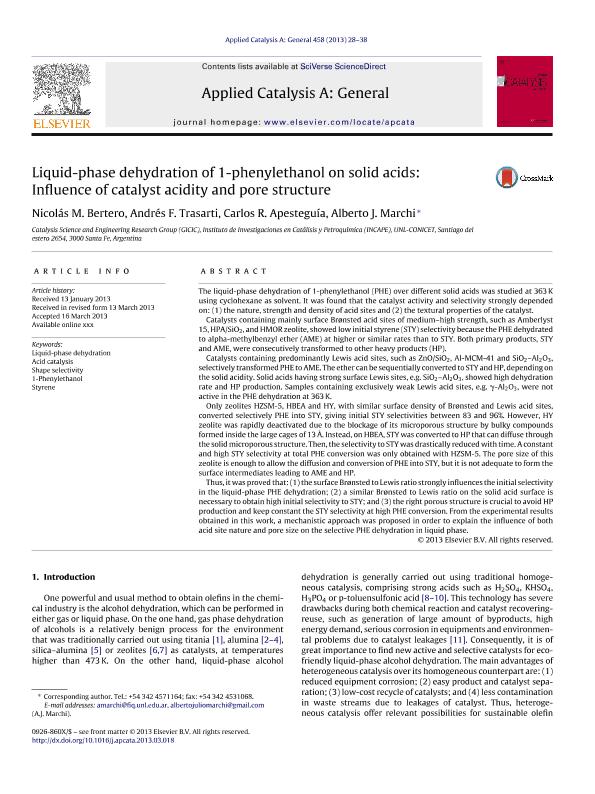Mostrar el registro sencillo del ítem
dc.contributor.author
Bertero, Nicolas Maximiliano

dc.contributor.author
Trasarti, Andres Fernando

dc.contributor.author
Apesteguia, Carlos Rodolfo

dc.contributor.author
Marchi, Alberto Julio

dc.date.available
2017-07-24T20:34:44Z
dc.date.issued
2013-03
dc.identifier.citation
Bertero, Nicolas Maximiliano; Trasarti, Andres Fernando; Apesteguia, Carlos Rodolfo; Marchi, Alberto Julio; Liquid-phase dehydration of 1-phenylethanol on solid acids:Influence of catalyst acidity and pore structure; Elsevier; Applied Catalysis A: General; 458; 3-2013; 28-38
dc.identifier.issn
0926-860X
dc.identifier.uri
http://hdl.handle.net/11336/21232
dc.description.abstract
The liquid-phase dehydration of 1-phenylethanol (PHE) over different solid acids was studied at 363 K using cyclohexane as solvent. It was found that the catalyst activity and selectivity strongly depended on: (1) the nature, strength and density of acid sites and (2) the textural properties of the catalyst. Catalysts containing mainly surface Br©ªnsted acid sites of medium?high strength, such as Amberlyst15, HPA/SiO2, and HMOR zeolite, showed low initial styrene (STY) selectivity because the PHE dehydrated to alpha-methylbenzyl ether (AME) at higher or similar rates than to STY. Both primary products, STY and AME, were consecutively transformed to other heavy products (HP). Catalysts containing predominantly Lewis acid sites, such as ZnO/SiO2, Al-MCM-41 and SiO2-Al2O3,selectively transformed PHE to AME. The ether can be sequentially converted to STY and HP, depending on the solid acidity. Solid acids having strong surface Lewis sites, e.g. SiO2-Al2O3, showed high dehydration rate and HP production. Samples containing exclusively weak Lewis acid sites, e.g. gamma-Al2O3, were not active in the PHE dehydration at 363 K. Only zeolites HZSM-5, HBEA and HY, with similar surface density of Br©ªnsted and Lewis acid sites, converted selectively PHE into STY, giving initial STY selectivities between 83 and 96%. However, HY zeolite was rapidly deactivated due to the blockage of its microporous structure by bulky compounds formed inside the large cages of 13¢ªA. Instead, on HBEA, STY was converted to HP that can diffuse through the solid microporous structure. Then, the selectivity to STY was drastically reduced with time. A constant and high STY selectivity at total PHE conversion was only obtained with HZSM-5. The pore size of this zeolite is enough to allow the diffusion and conversion of PHE into STY, but it is not adequate to form the surface intermediates leading to AME and HP. Thus, it was proved that: (1) the surface Br©ªnsted to Lewis ratio strongly influences the initial selectivity in the liquid-phase PHE dehydration; (2) a similar Br©ªnsted to Lewis ratio on the solid acid surface is necessary to obtain high initial selectivity to STY; and (3) the right porous structure is crucial to avoid HP production and keep constant the STY selectivity at high PHE conversion. From the experimental results obtained in this work, a mechanistic approach was proposed in order to explain the influence of both acid site nature and pore size on the selective PHE dehydration in liquid phase.
dc.format
application/pdf
dc.language.iso
eng
dc.publisher
Elsevier

dc.rights
info:eu-repo/semantics/openAccess
dc.rights.uri
https://creativecommons.org/licenses/by-nc-sa/2.5/ar/
dc.subject
Liquid-Phase Dehydration
dc.subject
Acid Catalysts
dc.subject
1-Phenylethanol
dc.subject
Styrene
dc.subject
Shape Selectivity
dc.subject.classification
Ingeniería de Procesos Químicos

dc.subject.classification
Ingeniería Química

dc.subject.classification
INGENIERÍAS Y TECNOLOGÍAS

dc.title
Liquid-phase dehydration of 1-phenylethanol on solid acids:Influence of catalyst acidity and pore structure
dc.type
info:eu-repo/semantics/article
dc.type
info:ar-repo/semantics/artículo
dc.type
info:eu-repo/semantics/publishedVersion
dc.date.updated
2017-07-19T20:34:59Z
dc.journal.volume
458
dc.journal.pagination
28-38
dc.journal.pais
Países Bajos

dc.journal.ciudad
Amsterdam
dc.description.fil
Fil: Bertero, Nicolas Maximiliano. Consejo Nacional de Investigaciones Científicas y Técnicas. Centro Científico Tecnológico Conicet - Santa Fe. Instituto de Investigaciones En Catalisis y Petroquímica "ing. Jose Miguel Parera". Universidad Nacional del Litoral. Instituto de Investigaciones En Catalisis y Petroquímica "ing. Jose Miguel Parera"; Argentina
dc.description.fil
Fil: Trasarti, Andres Fernando. Consejo Nacional de Investigaciones Científicas y Técnicas. Centro Científico Tecnológico Conicet - Santa Fe. Instituto de Investigaciones En Catalisis y Petroquímica "ing. Jose Miguel Parera". Universidad Nacional del Litoral. Instituto de Investigaciones En Catalisis y Petroquímica "ing. Jose Miguel Parera"; Argentina
dc.description.fil
Fil: Apesteguia, Carlos Rodolfo. Consejo Nacional de Investigaciones Científicas y Técnicas. Centro Científico Tecnológico Conicet - Santa Fe. Instituto de Investigaciones En Catalisis y Petroquímica "ing. Jose Miguel Parera". Universidad Nacional del Litoral. Instituto de Investigaciones En Catalisis y Petroquímica "ing. Jose Miguel Parera"; Argentina
dc.description.fil
Fil: Marchi, Alberto Julio. Consejo Nacional de Investigaciones Científicas y Técnicas. Centro Científico Tecnológico Conicet - Santa Fe. Instituto de Investigaciones En Catalisis y Petroquímica "ing. Jose Miguel Parera". Universidad Nacional del Litoral. Instituto de Investigaciones En Catalisis y Petroquímica "ing. Jose Miguel Parera"; Argentina
dc.journal.title
Applied Catalysis A: General

dc.relation.alternativeid
info:eu-repo/semantics/altIdentifier/doi/http://dx.doi.org/10.1016/j.apcata.2013.03.018
dc.relation.alternativeid
info:eu-repo/semantics/altIdentifier/url/http://www.sciencedirect.com/science/article/pii/S0926860X13001385
Archivos asociados
